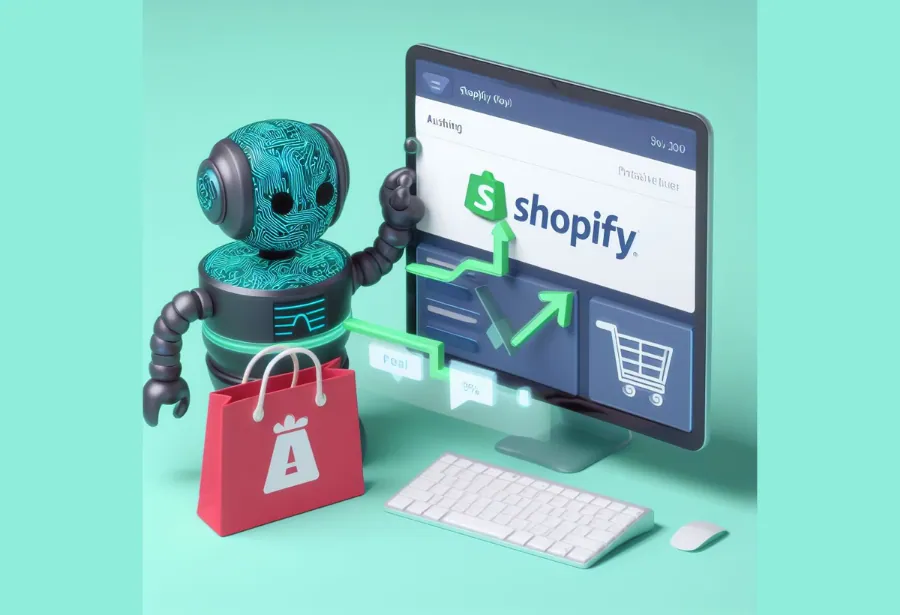“AI streamlines the Shopify website building process, empowering businesses to effortlessly create proficient and efficient online stores.”
There was once a time when artificial intelligence (AI) only existed in science fiction; now, AI is universal. Everything can be done with the aid of AI, from selecting the perfect outfit to the budget-friendly layout of a new house.
A wide range of other sectors are also using the technique. E-commerce, on the other hand, is rapidly expanding. To say that AI enormously impacts the e-commerce sector would be an understatement. With the power of AI, one can take the Shopify shop to the next level. In this post, you will find out why using AI Shopify website builder to launch an artificial intelligence-driven online shop is beneficial. Okay, so let’s begin!
What Is An AI-Powered E-Commerce Store?
The use of machine learning (ML) techniques and software to optimize an online store’s operations is what we call artificial intelligence (AI). It boosts the effectiveness of e-commerce operations and the online purchasing experience for clients.
With the use of AI, many retail functions, including product suggestions, loyalty discounts, and customer service, can be automated. A company owner can enjoy additional advantages with these. Let’s check out a few of them below:
Improving Your Shopify Online Store With Artificial Intelligence
Shopify AI website builder is an e-commerce platform that uses artificial intelligence to improve the shopping experience for customers in several ways.
Let’s check out the one at the top of the list.
Advantages Of Using AI With Your Shopify Online Store
- Increased Loyalty And Customer Retention
Returning customers are more valuable to a business than first-time visitors. They buy more than they used to, and they spread the word about your items to their networks of friends and family. The longer a customer shops with you, the more accurately AI can predict consumer trends and offer products to that customer based on what it has learned about them. This means you can automatically tailor experiences to each consumer depending on their channel preferences and history of engagement with your brand. Customer retention is another area where chatbots are effective. When salespeople have access to AI, they can programmatically respond to frequently asked questions and instantly update existing customers on their purchases. This eliminates any hesitation consumers can have about making a repeat purchase and creates satisfying interactions that keep them coming back.
- Personalized Product Suggestions
Most of the clients are generally drawn by customization. As a result, it’s crucial to assess each person’s specific requirements. It’s challenging to create the experience for every consumer personally. But did you realize that you can get these benefits by just incorporating AI into your Shopify ecommerce site as well? The site and the data they collect can teach AI new things, and the AI can use this knowledge to make product suggestions to users that are more likely to gain their trust and the business of those users.
Quick quizzes where customers can share their style preferences, tracking pixels to find related products that a customer is interested in, and in-depth information on who has visited what pages and made what actions on your website are just a few examples of the various artificial intelligence tools being used by multiple brands to make trustworthy product recommendations. In addition to these features, some retailers have also used AI chatbots to assist clients in locating appropriate items.
3. Effective Segmentation And Advertising
Due to the severe competition, e-commerce enterprises must concentrate their marketing efforts on delivering the proper message to the right audience at the right time. Getting things right might take a lot of work. Artificial intelligence (AI) advancements make segmenting audiences according to psychographic and demographic characteristics, like their most pressing problems, preferred lifestyle, and past online activities, easier than ever.
This information is regularly updated to target audiences with specific messages across various media. Artificial intelligence (AI) can even anticipate which channels a particular customer will use most often, allowing for a more natural, engaging delivery of advertisements and information. It can also deliver messages at specific times automatically.
Artificial intelligence (AI) can remind a consumer by email or text message if they have neglected to complete a purchase, for example.
4. Improvements In Customer Service
In the traditional storefront setup, a salesperson greets customers as they arrive and helps them find what they’re looking for if they have any questions.
Bringing this personal touch to internet retailers might take a lot of work. As a result, it’s easier for websites to provide personalized recommendations to their users if someone is on hand 24 hours a day, seven days a week. Artificially intelligent chatbots are to the rescue!
Artificially intelligent chatbots and salespeople are narrowing the gap between in-store and online shopping. They can answer immediate queries regarding items, shipping, and orders, make relevant product suggestions, and help clients locate the material and information they need to make purchase choices. The shop can deploy one of the many available chatbots to answer customers’ questions and help them make purchases.
5. Customer Experience Automation
Since no two clients are the same, it can be challenging for online retailers to provide the individualized service their customers expect. You can use AI to predict your audience’s next move, whether that’s making a purchase, contacting support, or writing a review, by feeding it all the data you have about them. Artificial intelligence (AI) is becoming better at anticipating customers’ wants and needs as it learns more about them. After that, it can automate each step or touchpoint to better meet the demands of the consumer.

